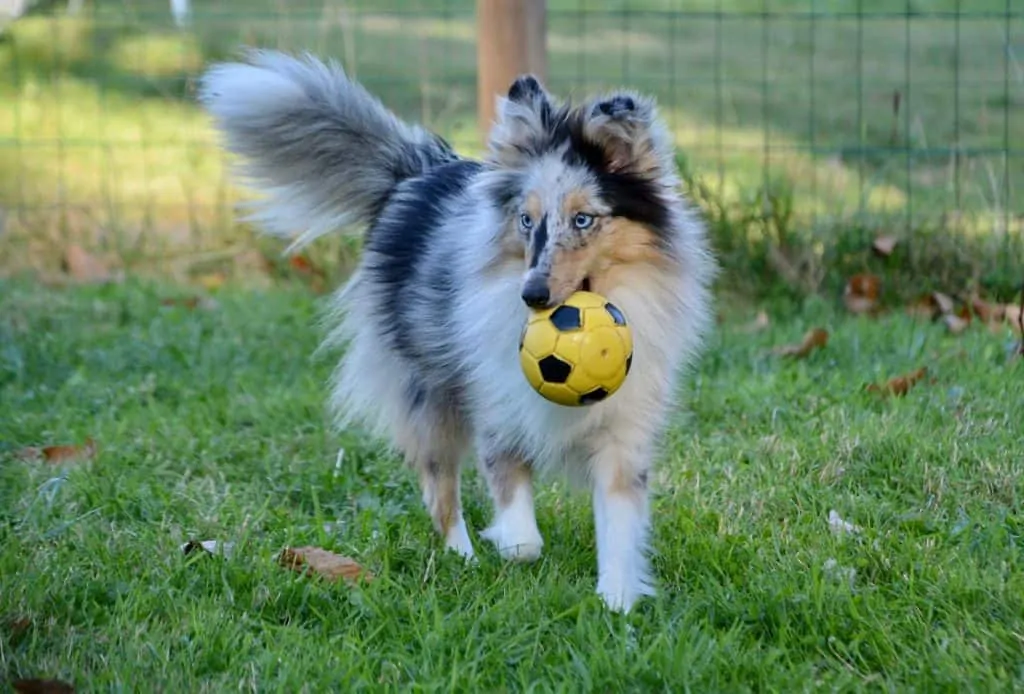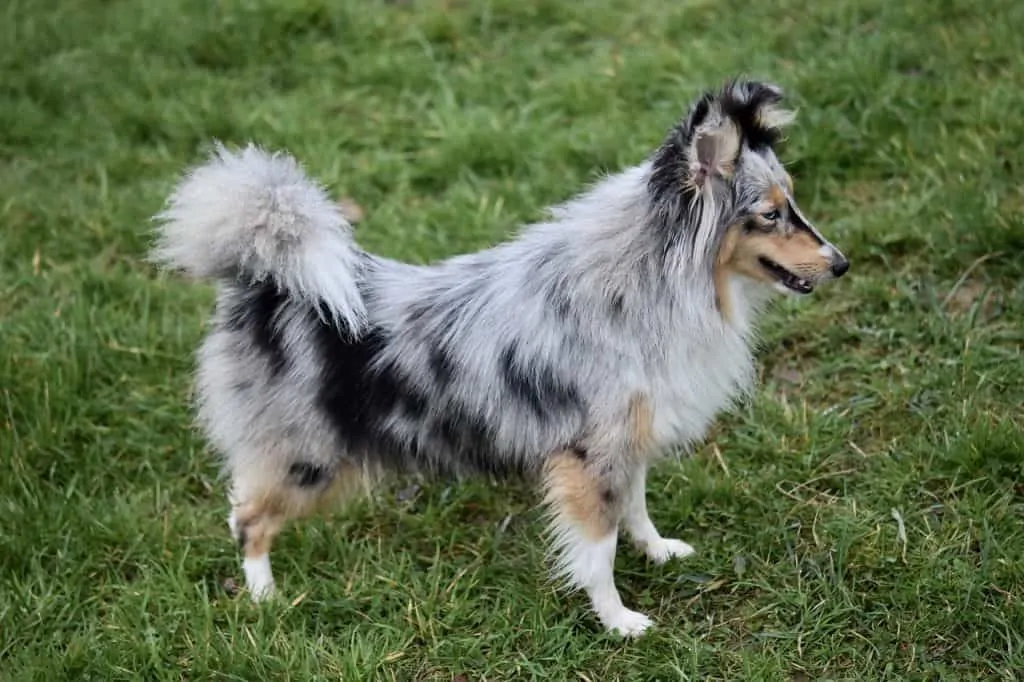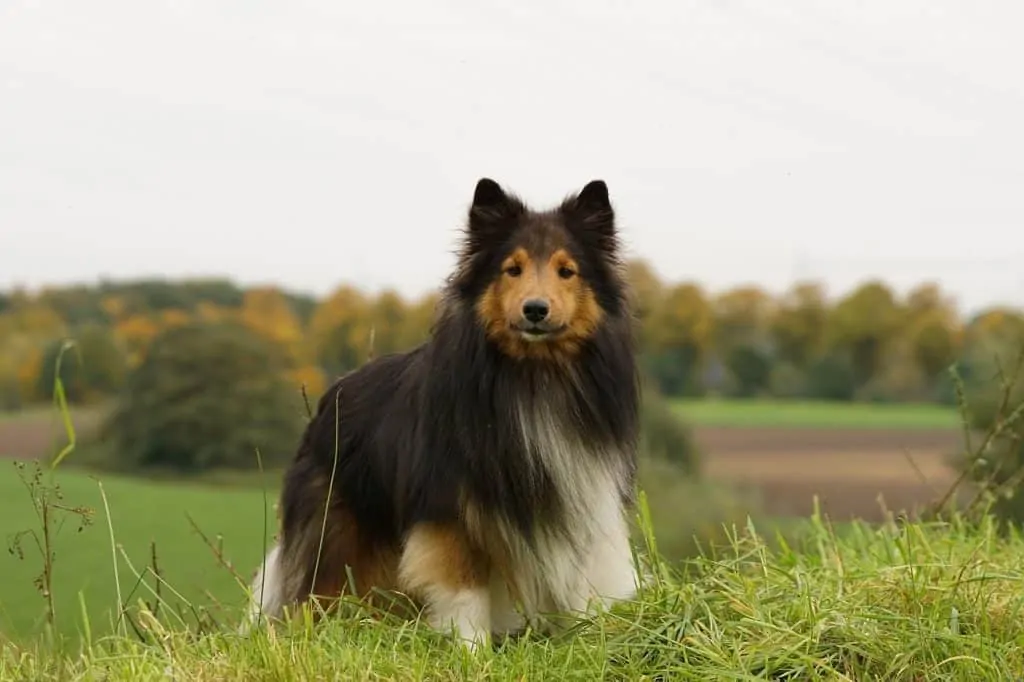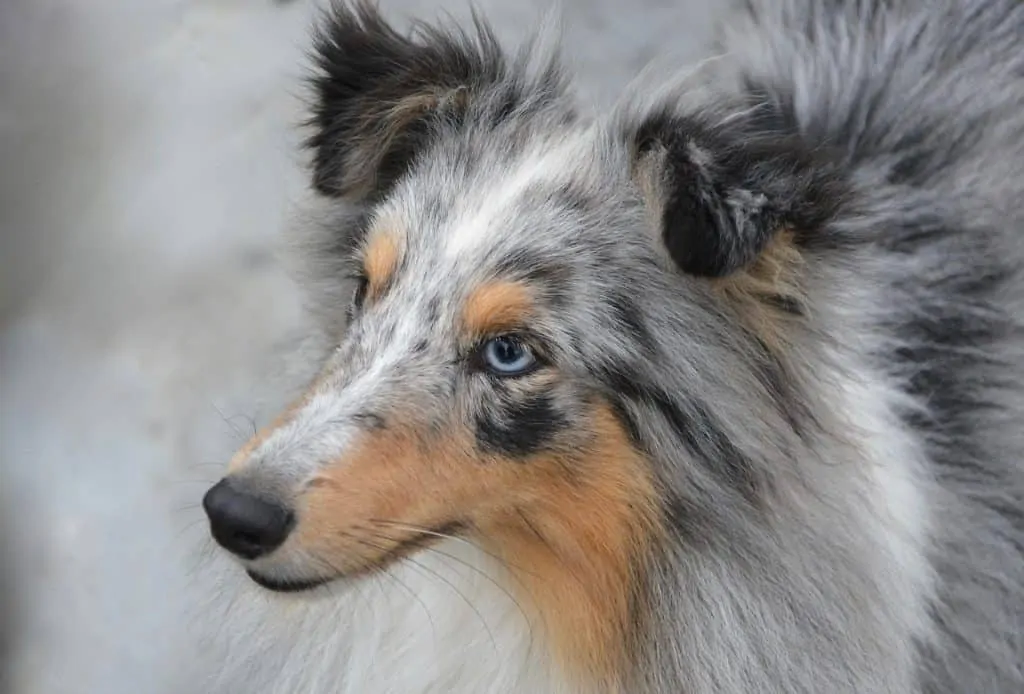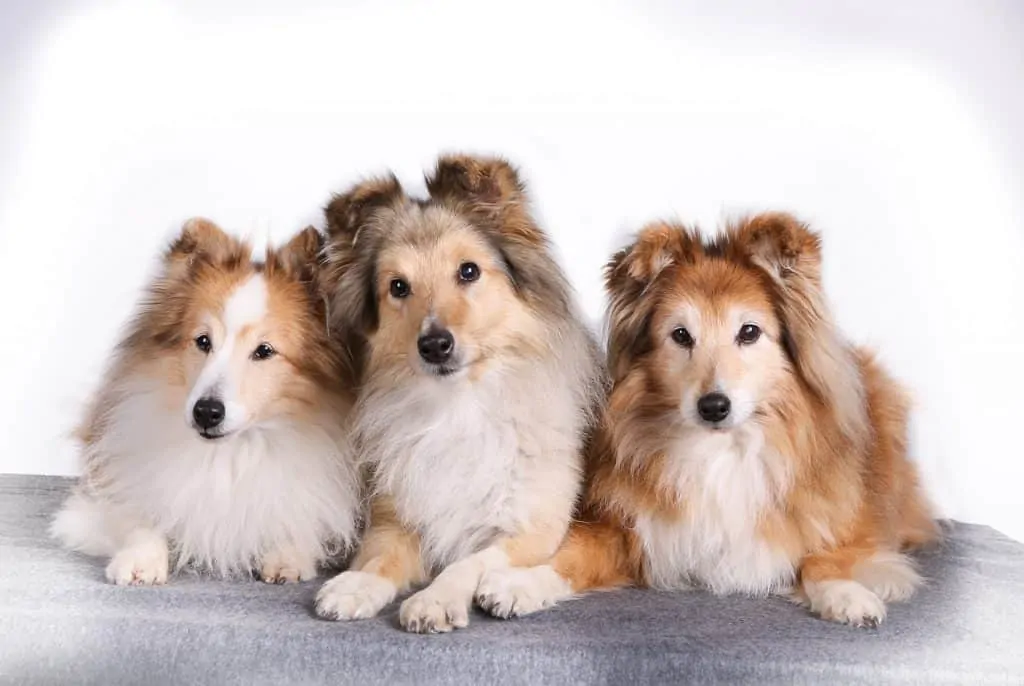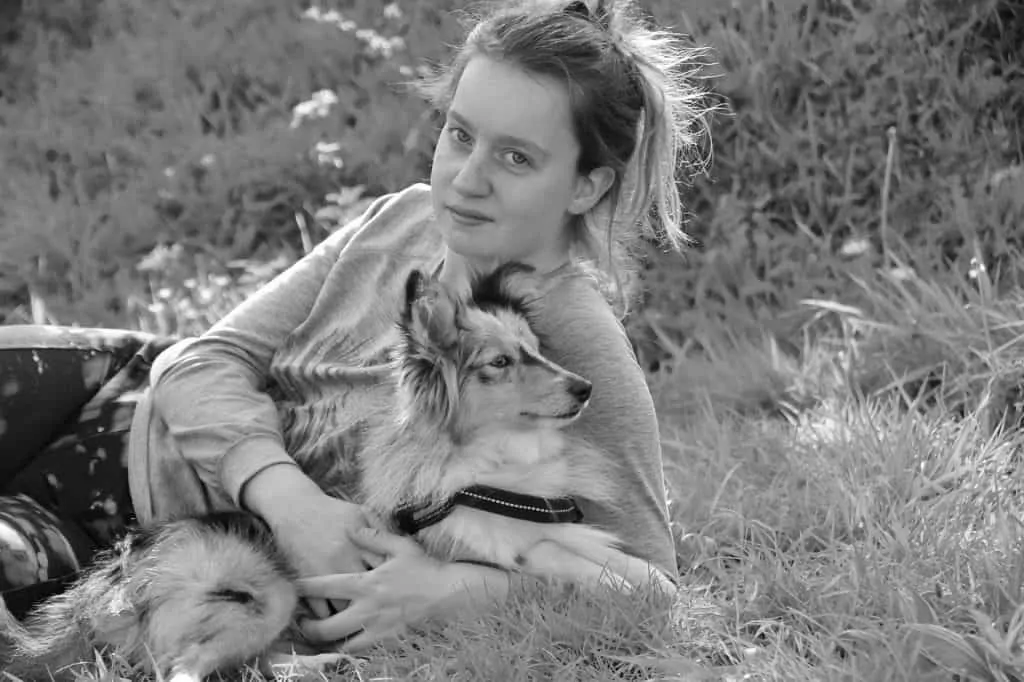Hailing from Scotland and often confused for a small Collie, the Shetland Sheepdog is beloved for his intelligence, trainability, and adaptive nature. This miniature Einstein is a family favorite, but is this the right dog breed for you?
If you’re considering bringing a Shetland Sheepdog into your home or family, you’ve come to the right place. Join us today as we learn all about the Shetland Sheepdog and discover if this is the perfect breed for your unique lifestyle.
Let’s get started!
Contents
What Is A Shetland Sheepdog?
The Sheltie is a cousin of the rough coated Collie, distinguishable by his smaller size.
Also known as the Sheltie, the Shetland Sheepdog is a small working dog originally bred for herding livestock. Due to his look, many novice dog enthusiasts may confuse this intelligent little breed for a small Collie, and while the two are related, they are no longer considered the same breed.
But more on that further down.
The Sheltie is a compact, adaptive companion who makes an excellent addition to both novice and experienced dog owners. He is highly trainable, gets along well with children and other animals, and enjoys learning new tricks, cues and games.
In fact, the Shetland Sheepdog has been deemed one of the most successful breeds when it comes to show, excelling particularly in the Obedience category. This should come as no surprise, considering the Sheltie is often considered one of the most intelligent breeds in the canine kingdom.
And while he makes a stellar companion for families throughout the world, the Shetland Sheepdog also enjoys employment as a professional tracking, herding, and service dog to those in need.
Where Does The Shetland Sheepdog Come From?
The Shetland Sheepdog originated in Scotland, on the Shetland Island
Small, nimble, and whip smart, the Shetland Sheepdog boasts humble working origins, hailing from the Shetland Islands of Scotaland. He was coveted as a hard working farm dog and employed on Scottish farms (also known as Toons) to herd small livestock like poultry, sheep and even Shetland Ponies.
Once referred to as a Toonie Dog, the Shetland Sheepdog is actually a bred down version of the rough-coated Collie. In fact, early on he was also called the Shetland Collie, though that name was changed to Shetland Sheepdog by breed fanciers.
The breed was a popular and essential companion for farmers throughout the Shetland Island, as their small size meant they were easier to feed and keep, and their quick wit and obedient nature made them excellent companions.
For a long time, the Sheltie was an island secret, living isolated on the Shetland Island until around the 20th century, when the breed was finally discovered by the rest of Europe. Still, it wasn’t until 1909 when the Shetland Sheepdog was finally recognized by the Kennel Club of England, and another two years passed before the breed was registered by the American Kennel club.
It did happen, though, with the Shetland Sheepdog becoming the 67th dog to be registered by the AKC.
Today, this brainy breed ranks in at number 25 out of 196 on the AKC’s list of America’s most popular dog breeds.
The Shetland Sheepdog Temperament And Personality Traits Like?
Shetland Sheepdogs are good natured, playful and very intelligent.
Along with his incredible intelligence, the Shetland Sheepdog is also beloved for his playful, gentle, and adoring temperament. While many highly intelligent dog breeds can be high maintenance and prone to behavioral issues if not properly trained and exercised, the Shelite is an anomaly.
He is a more adaptable genius who, so long as he is adequately exercised and kept mentally busy, is generally fine going with the flow.
He gets along well with children and other household pets when properly trained and socialized, though we should note that the Sheltie is a herding dog by nature and thus has a habit of running after anything that moves.
This could be problematic in homes with small children and other pets, however this behavior can be worked with and Shelties can be trained to harness this energy elsewhere. Remember, this is a breed who is one of the best and highest rated when it comes to obedience.
That said, the Shetland Sheepdog can be vocal and is known to be somewhat timid around strangers. While these attributes do make him an excellent watchdog, they can also be problematic for more social families who enjoy having company over often, or for those who live in smaller spaces with thinner walls.
Though standoffish when it comes to strangers, the Shetland Sheepdog is by no means timid when it comes to adventure. He enjoys being outdoors and will make a wonderful hiking, camping, and road tripping companion for active families.
On the flip side, this is also a dog who does well in more relaxed settings so long as he is properly exercised each day.
Keep reading to learn more about what this might entail.
What Are The Exercise and Training Requirements For A Shetland Sheepdog?
Shelties are eager to please and quick to learn.
Though athletic and energetic, the Shetland Sheepdog is small, which bodes well for families who prefer to enjoy living an active life on their terms. A good walk once a day should keep the Sheltie in ship shape, along with some playtime in the backyard.
For more active owners, the Sheltie makes a wonderful jogging partner, though bear in mind he will need to be disciplined to run alongside you, as many Shelties can be easily distracted by moving cars or other animals who tap into those chasing instincts.
Luckily, training a Shetland Sheepdog is a breeze. These dogs are highly trainable and eager to please, and thoroughly enjoy keeping their minds active to impress you. With that in mind, it’s important to stick with positive reinforcement training methods, as punishments or scolding could cause your Sheltie to shut down.
Utilize treats and praise, and make training sessions fun and gamelike. Keeping sessions short and repetitive will also help ensure your Sheltie learns quickly. Like many working breeds, your Shetland Sheepdog will also enjoy having a job to do around the house.
Though he is smaller than some of his other working dog counterparts, you can still encourage your Sheltie to help sort laundry, load the dishwasher, or bring in the mail or groceries.
Shetland Sheepdogs should also be taught a good recall, as they are quick to bolt after anything that moves, and this includes cars. You can also train your Sheltie when to stop barking on command to help reduce problems with excessive noise in smaller spaces like apartments.
Like all dogs, the Shetland Sheepdog should also be socialized at an early age. Remember, this is a dog who is by nature timid with strangers, so socializing him early can help reduce anxiety and decrease undesirable behaviors.
You can properly socialize your Shetland Sheepdog by taking him with you on as many outings as possible and exposing him to new sights, sounds, people and experiences. Try to make sure these first impressions are positive for him, and never force your Sheltie into a situation that frightens him, as this can compound the fear and lead to behavioral issues in the future.
And while Shetland Sheepdogs do well with children and other pets, it’s important to teach youngsters how to respectfully handle and play with dogs both inside and outside of the home to ensure everyone is happy and safe.
Of course, it’s always best to supervise very young children around the Shetland Sheepdog until they are old enough to be taught how to safely and gently play.
What Does A Shetland Sheepdog Look Like?
Shelties come in a variety of coat colors including blue merle, shown above.
You may have seen a Shetland Sheepdog plenty of times and not even known it! These dogs look so much like their Collie counterparts that they are often confused for them, though they can be distinguished by their more compact size.
Take a look.
Shetland Sheepdog Height: 13 to 16 Inches
Shetland Sheepdog Weight: 15 to 25 Lbs
Shetland Sheepdog Coat Color: Blue merle, sable, or black with white markings on the chest, paws, tail, and sometimes the head.
Coat Type: Rough and double coated with a wooley, dense undercoat and long, harsh outer coat.
Hypoallergenic Coat: No
Overview of the Shetland Sheepdog
Along with his compact size, the Sheltie is famous for his bright, expressive eyes, his erect ears, pointed muzzle and rounded body. Tails may either be long or docked, though docking is no longer required for show and in many markets it has even become discouraged.
How Do You Groom A Shetland Sheepdog?
Because of their dense coats, Sheltie’s can be prone to tangles and mats.
The Sheltie’s coat is one of his most prominent features. It is weatherproof, dense and long, which also means it is seriously prone to mats and tangles without proper grooming. The Shetland Sheepdog is also a profuse shedder, and as such will need routine brushing at least two to three times a week.
During shedding season, which occurs twice a year in spring and fall, the Sheltie will need to be brushed more often. It is also important for owners to check routinely for mats and tangles, looking closely behind your Sheltie’s ears, along his tail, and in the creases between his legs and belly.
Along with routine grooming using a slicker brush and deshedding tool, the Shetland Sheepdog will also need his teeth brushed at least once a day with a dog safe toothbrush and toothpaste.
His ears should be checked and cleaned often to ensure they don’t have buildup of moisture, debris or wax and his nails should be trimmed or ground down routinely to keep them from cracking or splitting.
Because of his weather resistant coat, the Sheltie does not need to be bathed often unless he gets especially dirty. Otherwise, your Sheltie should be fine with a bath every four to six weeks.
While the Sheltie’s coat can be overwhelming for some, it’s important to refrain from shaving him, as shaving a double-coated dog can result in a higher risk of heatstroke, sunburn, and skin issues.
That said, his coat can grow quite long and he will need to be routinely trimmed, especially around his paws, buttox, ears and legs.
What Is the Average Lifespan Of A Shetland Sheepdog And Do They Have Any Serious Health Issues?
Shetland Sheepdogs are relatively healthy dogs.
Good breeding practices over the years have helped to ensure that the Shetland Sheepdog is a healthy and robust breed as a whole. Of course, like all dogs, the Sheltie can be prone to suffering from genetic health issues you should be aware of.
With an average lifespan of 12 to 14 years, the Shetland Sheepdog is most prone to:
- Hip Dysplasia
- Dermatomyositis (AKA Sheltie Skin Syndrome)
- Thyroid Disease
- Eye Disease
- Von Willebrand’s Disease (vWD)
- Epilepsy
- And Gallbladder Mucoceles
According to the National Breed Club, the Sheltie is encouraged to undergo the following recommended health screenings:
- Ophthalmologist Evaluation
- And Hip Evaluation
You can help combat potential issues with your Shetland Sheepdog by ensuring you get him from a reputable source like a responsible breeder or trusted shelter. Keeping up with grooming routines and exercise will also help keep your Sheltie feeling his best, as well ensuring he maintains a healthy and balanced diet.
The Shetland Sheepdog will do best on a high quality dog food that is rich in proteins, vitamins, minerals, and other nutrients he needs to thrive. Food should be free of additives and fillers like by products, dyes and artificial flavors, and specified for your Sheltie’s age, weight and activity level.
What Are Some Pros And Cons Of Owning A Shetland Sheepdog?
Shetland Sheepdogs can be quite vocal, which can be problematic for some.
The Shetland Sheepdog may be the perfect dog for some, but is he the perfect dog for you? Before you decide to invest in a Sheltie dog, it’s a good idea to weigh the pros and cons.
Pros To Owning A Shetland Sheepdog :
- Shetland Sheepdogs are incredibly smart and quick to learn
- Shelties do well with children and other dogs when properly socialized and trained
- Shelties make wonderful watch dogs
- They are compact in size and easy to travel with
- Shelties are relatively healthy dogs with decent lifespans
- They bond closely to their families
- Shelties are adaptable companions for both city living and suburban living
Cons To Owning A Shetland Sheepdog :
- Shelties can be vocal and will need to be trained to stop barking
- Shetland Sheepdogs are herding dogs by nature and chase instinctively
- They can be wary of strangers and will need to be properly socialized
- Shelties are prone to skin issues and may have food sensitivities
- They are profuse shedders who need consistent grooming
- Without proper mental and physical stimulation, Shetland Sheepdogs can be prone to destructive behaviors and anxiety.
What Is The Ideal Home Type For A Shetland Sheepdog?
Shetland Sheepdogs are quite adaptable to both city and suburban homes.
Because of their compact size, Shetland Sheepdogs are adaptable companions to both city and suburban life. While having a backyard would be ideal for this breed of dog, they can do well in apartments so long as they are properly exercised and their clever minds are kept busy.
Shelties are athletic and enjoy adventures and outings with their people, but they are also just as content to sit beside their human family members for a relaxing day watching movies.
The ideal family for a Sheltie dog would include owners who have a flexible schedule and have time to exercise and play with their dog.
The Sheltie will do best in homes where he gets to be an active part of the family and with owners who appreciate his unique intelligence and are willing and eager to harness all that brain power into something positive. Owners should also prepare and be willing to deal with a bit of barking from time to time.
Choosing A Shetland Sheepdog Puppy Or Rescue – Tips On Finding The Healthiest Shetland Sheepdog Possible.
Getting your Sheltie puppy or rescue from a reputable source is the best way to ensure he starts off happy and healthy.
Have you decided that the Shetland Sheepdog is right for you? Whether you’ve opted to get yourself a puppy from a breeder or an adult dog from a shelter or rescue, or it’s imperative that you do your research and ensure you are getting your dog from a reputable source.
When going through a breeder, make sure the breeder is certified and has a background in breeding Sheltie dogs. Be wary of online sellers and backyard breeders offering Shetland Sheepdogs at a discounted rate, as this raises your chances of winding up with a sick puppy, which could end up costing you much more money down the road.
On average, reputable breeders charge around $800 to $1000, though this price can vary depending on the breeder and the Shetland Sheepdog’s parents. Keep in mind that puppies who come from show quality parents are often much more expensive than those who come from parents bred soley for companionship.
While going through a breeder can be costly, there are benefits. Reputable breeders should be able to offer you health certificates proving their dogs have been health screened and cleared of any serious genetic health issues prone to the breed.
They may also allow you to see the puppy’s mother, which will give you a good idea of what your Sheltie will grow up to look and behave like.
Of course, going through a breeder is not the only way to get your hands on a perfect Shetland Sheepdog. In fact, there are plenty of rescues throughout the United States that specialize in the breed and should be able to help connect you with the dog of your dreams.
Going through a shelter is a great way to cut costs when looking for a Sheltie, but there are plenty of other benefits that coincide with adopting a dog. Along with providing a dog a good and loving home, you may also be able to avoid some of the more trying puppyhood problems by adopting an adult Sheltie whose personality is more predictable.
Many shelters and rescues also provide free initial vet exams, and oftentimes their dogs have been pre-screened for major health issues and behavioral problems before being released for adoption.
The Top 5 Products Every Shetland Sheepdog Owner Needs
Preparing your home for a Shetland Sheepdog is key to a good start together.
If you’ve decided the Shetland Sheepdog is right for you, then you’re in luck. We’ve done some research and compiled a list of the top five products every Shetland Sheepdog family needs to help their Sheltie start off on the right paw.
Take a look!
The FURminator Undercoat Deshedding Brush
No products found.
The FURminator is one of our favorite deshedding brushes because it works specifically for dogs with dense undercoats like the Shetland Sheepdog. This brush is best at collecting and removing loose hair that becomes tangled beneath the surface, helping to reduce doggy odor and alleviate skin issues and tangles.
The comb also includes a rejector button to help quickly remove loose hair from the bristles of the brush so you may continue grooming your Sheltie without stopping too often.
Safari Stainless Steel Dematting Comb
No products found.
Another important grooming tool to have on hand with the Shetland Sheepdog is a quality dematting comb. Because of their long, dense coats, Shetland Sheepdogs can be prone to serious mats along their hind legs, on their belly, and behind their ears.
A dematting comb can help you work through minor mats and tangles without damaging the fur or skin, though very thick mats will need to be cut out to avoid hurting your Sheltie.
Wellness Simple Limited Ingredient Diet Dog Food
No products found.
Shelties tend to suffer from skin issues and can be prone to food sensitivities. For this reason, we recommend a quality dog food that is made with limited ingredients and that is geared towards skin and coat health, amongst other things.
We like Wellness Simple LID dog food because it is made with quality ingredients and is free of fillers, additives and byproducts. It also comes in a grain free option, for especially sensitive pups.
This is a dry dog food that is designed to ease digestive issues in dogs and support your Sheltie’s skin and coat, while also being packed full of taurine and probiotics for heart health and glucosamine for joints and bones.
PetSafe Easy Walk Dog Harness
No products found.
Shelties are fabulous dogs to work with and train, and they often make the most agreeable of walking partners. That said, they do have an instinct to chase, so it’s a good idea to invest in a quality dog harness that reduces pulling and will redirect them safely back to you if they choose to bolt during an outing.
The above Easy Walk dog harness is one of our favorites and works well to safely and effectively redirect dogs who pull during walks. It is also gentle on your Shetland Sheepdog’s sensitive trachea and will make for more comfortable walks all around.
Trixie Pet Products Advanced Dog Puzzle Toy
No products found.
Remember, the Shetland Sheepdog is one of the most intelligent canines around, so keeping his active mind busy and occupied is important and will help reduce anxiety and destructive behaviors.
Puzzle toys work wonders for brainy breeds like the Sheltie, and we especially like the above puzzle toy for more advanced breeds. This toy utilizes treats to hold your dog’s focus and can be ordered in several styles to keep your dog busy and challenged.
So, what do you think about the Shetland Sheepdog now that you know more about him? Is this the perfect breed for you? We would love to hear your thoughts! Leave us a comment with your opinion below.
Thanks for reading!


Jen Jones is a professional dog trainer and behavior specialist with more than 25 years of experience. As the founder of ‘Your Dog Advisor’ and the ‘Canine Connection’ rehabilitation center, she applies a holistic, empathetic approach, aiming to address root causes rather than merely treating symptoms.
Well known for her intuitive and compassionate approach, Jen adopts scientifically-proven, reward-based methods, encouraging positive reinforcement over punishment. Jen specializes in obedience training, behavior modification, and puppy socialization. Her innovative methods, particularly in addressing anxiety and aggression issues, have been widely recognized. Jen has worked with many of the world’s leading dog behaviorists and in her free time volunteers with local animal shelters and rescue groups.


